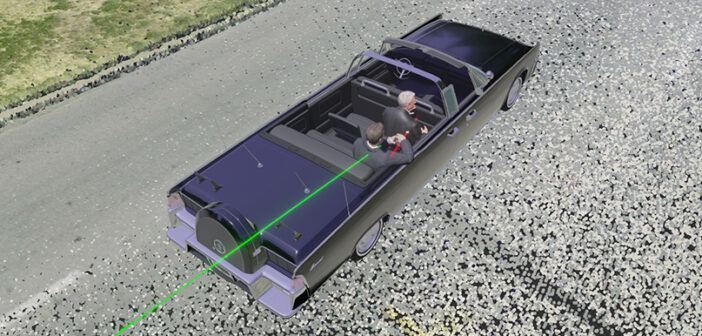Knott Laboratory is a multidisciplinary team of engineers, accident reconstructionists, and animators who provide Forensic Engineering and Visualisation Services. Its team of experts have worked on over 20,000 forensic cases in the US. The company has developed an industry-leading process – which takes video footage and merges it with an accurate 3D point cloud of an accident site.

A Knott Laboratory digital reconstruction of Dealy Plaza overlayed with photographic imagery.
The point cloud acts as a virtual representation of the scene, allowing engineers from Knott Laboratory to identify crucial details like the positions and distances of people and objects, the timeline of events, the speed and motion of objects, locations of evidence, and more.
In this blog, CEO and Principal Engineer, Stanley Stoll explains how and why the company uses point clouds – generated using Hexagon’s reality capture solutions – to visually communicate key case details for its clients. A high-profile example is the company’s work on the analysis of evidence in the 2018 wrongful death lawsuit against the three-time NASCAR Cup champion Tony Stewart.
The problem with traditional video analysis
Video evidence is now ubiquitous in investigations, from mobile phone footage to body cams and surveillance videos. However, traditional video analysis has its limitations. Factors like lens distortion can skew perspective and distances. The quality of the video is affected by lighting and camera placement. Moreover, standard video only provides one vantage point, which can be misleading and make it difficult to determine what actually happened.

Lens distortion occurs when the shape of an object is inaccurately reproduced
Lens distortion is a common problem in photography and video analysis. It occurs when the camera lens does not accurately reproduce the shape of objects in the image. There are two main lens distortion types: radial and tangential. Radial distortion occurs when straight lines appear curved in the image, while tangential distortion occurs when the image appears tilted or skewed.
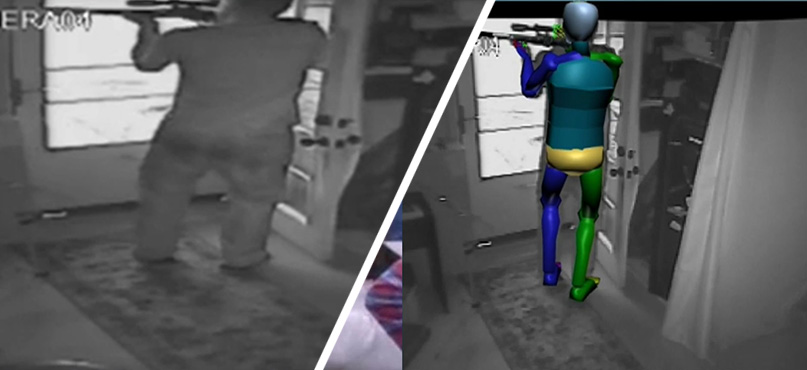
Lens distortion in video can be overcome with accurate 3D laser scanning
Knott Laboratory uses photogrammetry and point cloud data to reduce these limitations. Engineers aim to provide the most scientifically accurate video analysis possible and uncover as much information as can currently be gained from video evidence.
Expanding the data with photogrammetry and point clouds
Photogrammetry utilises images and algorithms to create 3D representations of objects or environments. In the context of video evidence, photogrammetry can be used to create 3D models of crime scenes, which forensic engineers can then analyse from different angles and perspectives. Knott combines photogrammetry techniques with point cloud data, which the engineers capture at a scene using 3D laser scanning solutions. By matching video footage to point clouds created from a scene, new details that were impossible to see in the original video are uncovered.
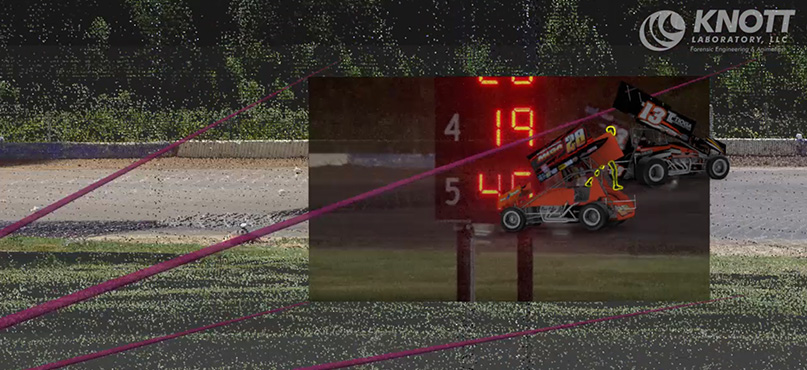
Knott Laboratory animated point-cloud of the NASCAR crash
Knott combines point cloud data with other methods like motion capture, interactive visualisations, and virtual reality to provide a scientifically accurate and visually transparent presentation of the facts for legal teams and juries. Knott’s goal with point clouds is to eliminate issues and visually communicate key case details.
The benefits of incorporating point clouds
The benefits of matching video evidence to point clouds are substantial. It allows analysis with greater accuracy and more spatial context. Multiple vantage points come into play. Measurements and positions can be precisely determined based on the fixed reference points of the point cloud. Scenarios can be visualised and reconstructed digitally from any angle. Overall, the extra geometric details from point clouds provide supplementary cues that can assist in video analysis.
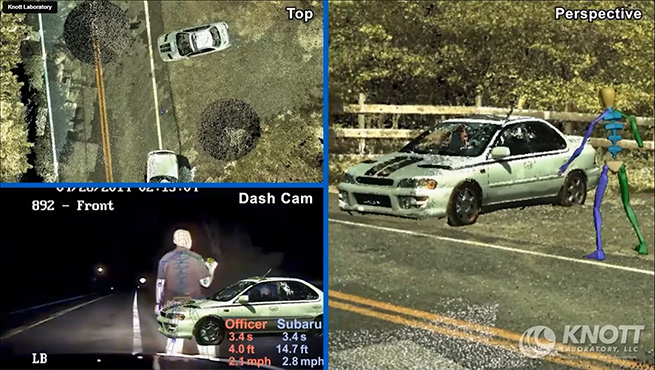
Knott Laboratory digital forensics of a vehicular incident
By aligning video footage to a point cloud of the same space, the investigator can gain extra spatial context about what is shown in the video. This helps to understand distances and depths better. With the alignment to a point cloud’s real-world coordinate system, measurements like distance, size, etc., can be extracted from the video frames, which can provide quantifiable data from the footage.
Matching video frames to point clouds enables estimating the position and orientation of the camera as it moves through space. Investigators can use it for reconstructing camera trajectories and viewpoints. In addition, virtual camera viewpoints different from the original video can be synthesised using the point cloud geometry for new perspectives.
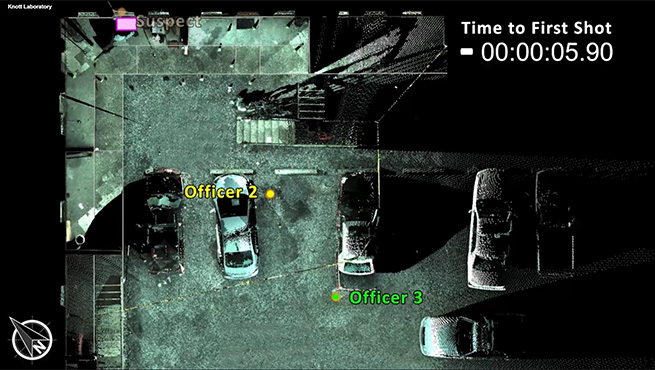
Knott Laboratory digital forensics for crime investigation
Applying Digital Media Forensics to investigations: Kevin Ward Jr. wrongful death suit
On August 9th, 2014, NASCAR legend Tony Stewart was racing in a Sprint Car Series event in Canandaigua, NY. During the highly competitive race, Stewart attempted to overtake a fellow racer, Kevin Ward Jr., whose car ended up in the wall. After exiting his vehicle, he was struck by Stewart’s car under a yellow caution flag, resulting in the death of Mr. Ward.
The case was in the national spotlight, and Knott Laboratory was contracted to reconstruct the event. Its engineers and animators used 3D laser scanning data and video footage to reconstruct the event with scientific accuracy. Knott’s findings proved to be pivotal for the civil case and are the subject of The Hit, an investigative documentary on the incident.
To reconstruct the event Knott’s engineers conducted multiple scans of the racetrack using a Leica RTC360 laser scanner to develop a 3D point cloud of the incident scene.
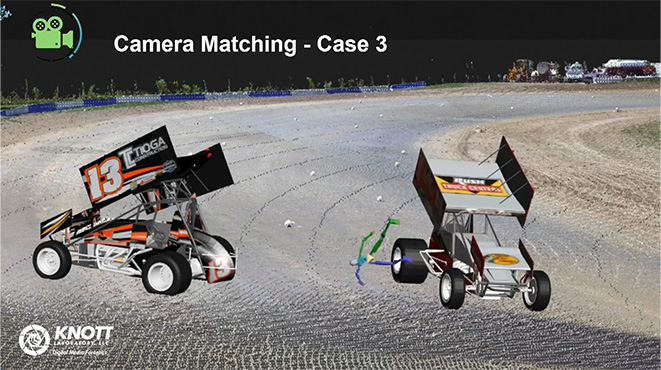
Knott Laboratory animation of the Kevin Ward incident
An example vehicle was also scanned and placed into the point cloud data. Investigators deployed the RTC360 because of its efficiency and ease of use. The speed with which Knott can complete scans is beneficial while scanning a dangerous or live environment. It’s also easy to process the captured data from the RTC360 via Leica Cyclone REGISTER 360 PLUS software and integrate it into the workflow, which includes a variety of specialist packages.
Engineers then performed camera matching analysis to align the video footage and point cloud data to determine the precise positions and depths of vehicles during the incident. This provided new aerial perspectives, which showed that the speed, acceleration, angle, and path of Stewart’s vehicle differed from others before impact.

Knott Laboratory animated point cloud of the Kevin Ward incident
Knott’s job is to present the best possible analysis; matching video evidence to point clouds allowed it to do so. The forensics suggests that Stewart applied the throttle, causing his car to drift up the track. Had this evidence been available in the initial criminal investigation, the finding might have been different.
As Knott’s work reconstructing the Kevin Ward Jr. incident shows, point cloud-based video analysis allows investigators to uncover previously hidden details, providing clarity for more informed inquiries and outcomes. This technology has become a critical tool; as video evidence increases, so does the need for advanced analysis methods.
While there are always limitations, leveraging point clouds can extract more information than ever before. This enables Knott’s experts to provide scientifically rigorous analysis that gives clients and juries a clearer picture of what occurred. It takes scientific video analysis to a new level.
Author: Stanley C. Stoll, CEO and a Principal Engineer at Knott Laboratory
Click here to learn more about Hexagon’s Public Safety, Security and Forensics














